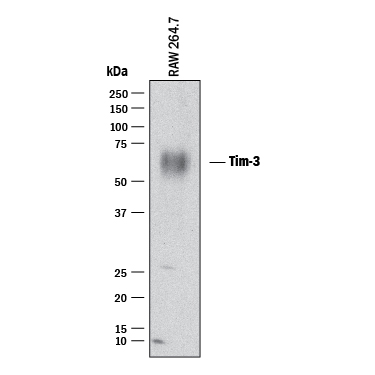Mouse TIM-3 Antibody Summary
Leu22-Arg191
Accession # AAL65156
Applications
Please Note: Optimal dilutions should be determined by each laboratory for each application. General Protocols are available in the Technical Information section on our website.
Scientific Data
 View Larger
View Larger
Detection of Mouse TIM‑3 by Western Blot. Western blot shows lysates of RAW 264.7 mouse monocyte/macrophage cell line. PVDF membrane was probed with 2 µg/mL of Goat Anti-Mouse TIM-3 Antigen Affinity-purified Polyclonal Antibody (Catalog # AF1529) followed by HRP-conjugated Anti-Goat IgG Secondary Antibody (Catalog # HAF017). A specific band was detected for TIM-3 at approximately 45-70 kDa (as indicated). This experiment was conducted under reducing conditions and using Immunoblot Buffer Group 1.
 View Larger
View Larger
TIM‑3 in Mouse Spleen. TIM‑3 was detected in immersion fixed paraffin-embedded sections of mouse spleen using Goat Anti-Mouse TIM‑3 Antigen Affinity-purified Polyclonal Antibody (Catalog # AF1529) at 3 µg/mL for 1 hour at room temperature followed by incubation with the Anti-Goat IgG VisUCyte™ HRP Polymer Antibody (VC004). Before incubation with the primary antibody, tissue was subjected to heat-induced epitope retrieval using Antigen Retrieval Reagent-Basic (CTS013). Tissue was stained using DAB (brown) and counterstained with hematoxylin (blue). Specific staining was localized to lymphocytes. Staining was performed using our protocol for IHC Staining with VisUCyte HRP Polymer Detection Reagents.
Reconstitution Calculator
Preparation and Storage
- 12 months from date of receipt, -20 to -70 °C as supplied.
- 1 month, 2 to 8 °C under sterile conditions after reconstitution.
- 6 months, -20 to -70 °C under sterile conditions after reconstitution.
Background: TIM-3
TIM-3 (T cell immunoglobulin and mucin domain-3) is a 60 kDa member of the TIM family of immune regulating molecules. TIMs are type I transmembrane glycoproteins with one Ig-like V-type domain and a Ser/Thr-rich mucin stalk (1-3). There are three TIM genes in human and eight in mouse. Mature mouse TIM-3 consists of a 174 amino acid (aa) extracellular domain (ECD), a 21 aa transmembrane segment (TM), and a 67 aa cytoplasmic tail (4). Two alternately spliced isoforms have been reported in mouse which lack either the TM or both the TM and mucin regions (5, 6). Within the ECD, mouse TIM-3 shares 58% and 74% aa sequence identity with human and rat TIM-3, respectively. TIM-3 is specifically expressed on Th1 cells whereas TIM-1 and TIM-2 are expressed on Th2 cells. In chronic inflammation, autoimmune disorders, and some cancers, TIM-3 is upregulated on several other hematopoietic cell types and on hippocampal neurons (9-12). The glycosylated Ig domain of TIM-3 binds cell-associated galectin-9 which induces TIM-3 Tyr phosphorylation and proapoptotic signaling (10, 13). TIM-3 functions as a negative regulator of Th1 cell activity. Its blockade results in increased IFN-gamma production, Th1 cell proliferation, and cytotoxicity (5, 7, 12, 14). TIM-3 may play a role in regulatory T cell development (7), inflammation (15), and immune tolerance (5, 13, 14). Soluble mouse TIM-3 has been shown to inhibit anti-tumor effector T cell responses and to enhance autoimmune reactions (6, 7).
- Anderson, A.C. and D.E. Anderson (2006) Curr. Opin. Immunol. 18:665.
- Mariat, C. et al. (2005) Phil. Trans. R. Soc. B 360:1681.
- Meyers, J.H. et al. (2005) Trends Mol. Med. 11:362.
- Monney, L. et al. (2002) Nature 415:536.
- Sabatos, C.A. et al. (2003) Nat. Immunol. 4:1102.
- Geng, H. et al. (2006) J. Immunol. 176:1411.
- Sanchez-Fueyo, A. et al. (2003) Nat. Immunol. 4:1093.
- Khademi, M. et al. (2004) J. Immunol. 172:7169.
- Wiener, Z. et al. (2007) J. Invest. Dermatol. 127:906.
- van de Weyer, P.S. et al. (2006) Biochem. Biophys. Res. Commun. 351:571.
- Gielen, A.W. et al. (2005) J. Neuroimmunol. 164:93.
- Oikawa, T. et al. (2006) J. Immunol. 177:4281.
- Zhu, C. et al. (2005) Nat. Immunol. 6:1245.
- Koguchi, K. et al. (2006) J. Exp. Med. 203:1413.
- Frisancho-Kiss, S. et al. (2006) J. Immunol. 176:6411.
Product Datasheets
Citations for Mouse TIM-3 Antibody
R&D Systems personnel manually curate a database that contains references using R&D Systems products. The data collected includes not only links to publications in PubMed, but also provides information about sample types, species, and experimental conditions.
3
Citations: Showing 1 - 3
Filter your results:
Filter by:
-
Transcriptomic Hallmarks of Tumor Plasticity and Stromal Interactions in Brain Metastasis
Authors: E Wingrove, ZZ Liu, KD Patel, A Arnal-Esta, WL Cai, MA Melnick, K Politi, C Monteiro, L Zhu, M Valiente, HM Kluger, VL Chiang, DX Nguyen
Cell Rep, 2019-04-23;27(4):1277-1292.e7.
Species: Mouse
Sample Types: Whole Tissue
Applications: IHC -
The HIF-1/glial TIM-3 axis controls inflammation-associated brain damage under hypoxia.
Authors: Koh H, Chang C, Jeon S, Yoon H, Ahn Y, Kim H, Kim I, Jeon S, Johnson R, Park E
Nat Commun, 2015-03-20;6(0):6340.
Species: Mouse
Sample Types: Whole Cells
Applications: ICC -
TIM-1 and TIM-3 enhancement of Th2 cytokine production by mast cells.
Authors: Nakae S, Iikura M, Suto H, Akiba H, Umetsu DT, DeKruyff RH, Saito H, Galli SJ
Blood, 2007-07-09;110(7):2565-8.
Species: Mouse
Sample Types: Cell Lysates
Applications: Western Blot
FAQs
No product specific FAQs exist for this product, however you may
View all Antibody FAQsReviews for Mouse TIM-3 Antibody
There are currently no reviews for this product. Be the first to review Mouse TIM-3 Antibody and earn rewards!
Have you used Mouse TIM-3 Antibody?
Submit a review and receive an Amazon gift card.
$25/€18/£15/$25CAN/¥75 Yuan/¥2500 Yen for a review with an image
$10/€7/£6/$10 CAD/¥70 Yuan/¥1110 Yen for a review without an image

